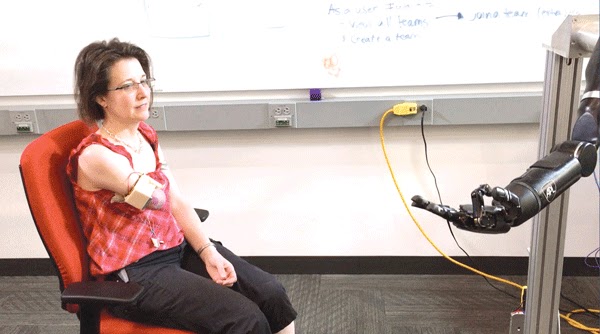In the Pursuit of Touch
by Camila Rejalaga
for @hackinhumans
Since 710 BC humans have been
trying to overcome the difficulties of not having a limb. For many generations,
the purpose of prosthetics has been to feel an empty hole and not recovering
the functions of what we have lost. This last century technology has allowed us
to create prosthetic limbs that gives humans back the ability to run, grab
objects, tie your shoe laces and other mundane stuff that we usually take for
granted in life. But one thing has been missing from the equation, the ability
to recover the senses of a lost limb, something deemed a limitation in bionic
limbs. Thanks to technological innovation mind-controlled limbs are no longer a
subject of a futuristic movie but an assured occurrence.
 To go into how we could control
with our minds a prosthetic arm we must first understand the concept of
targeted muscle reinnervation. John Hopkins Hospital defines it “as a new
surgical procedure that reassigns nerves that once controlled the arm and the
hand. By reassigning existing nerves, doctors can make it possible for people
who have had upper-arm amputations to control their prosethic devices by merely
thinking about the action they want to perform.” If eligible to go through this
operation you get the chance not to only be able to tell the bionic arm with
your mind that you want to grab a ball but to gain the feeling of holding the
ball. One of the greatest downfall of prosthetics limbs couldn’t solve for
people was the lack of sense it offered.
To go into how we could control
with our minds a prosthetic arm we must first understand the concept of
targeted muscle reinnervation. John Hopkins Hospital defines it “as a new
surgical procedure that reassigns nerves that once controlled the arm and the
hand. By reassigning existing nerves, doctors can make it possible for people
who have had upper-arm amputations to control their prosethic devices by merely
thinking about the action they want to perform.” If eligible to go through this
operation you get the chance not to only be able to tell the bionic arm with
your mind that you want to grab a ball but to gain the feeling of holding the
ball. One of the greatest downfall of prosthetics limbs couldn’t solve for
people was the lack of sense it offered.
Once successfully completing the
operation, the next step is testing the modular prosthetic limb. For the
modular prosthetic limb to work, the nerves were surgically grafted into a
location in the remaining upper arm so that those nerves could be connected to
a sensory cap that attaches the arm to the prosthesis (John Hopkins Magazine
2017). As you can see in the picture,
Melissa Loomis, a woman who lost her arm due to a raccoon bite infection has
the sensory cap attached to her arm. With the muscle reinnervation and the
sensory cap she is able to move the bionic limb with her hand. She thinks about
closing her hand, the bionic arm does it. What’s more impressive is the 100
sensors in the arm that sends signals to the brain that you are holding
something, you can feel the object in a bionic arm.



Comments
Post a Comment